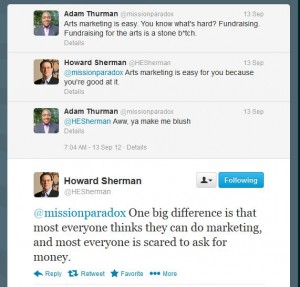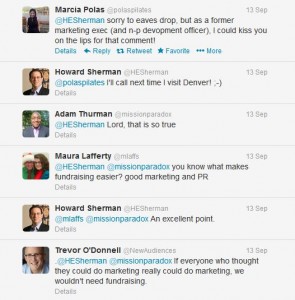Seeing and hearing about people queuing up this year for Black Friday sales on the Monday prior reminded me about an article Tim Roberts wrote on Fullhouses.org this September. In it, Roberts asked if making people line up for theatre tickets was really the fairest way to distribute them.
I am sure the British Commonwealth nations who sponsor Fullhouses.org don’t experience the homicidal shopping frenzy that is Black Friday, but it occurred to me that it is something of a double standard to expect arts organizations to be fairer than retail stores.
It isn’t fair to have to take time off of work to stand in line for theatre tickets, but people camp out for a week to get $50 off a flat screen TV and no one blinks, eh?
Arts organizations are expected to operate more like businesses, aren’t we? Why not make people line up and wait? We may be worried about hurting our relationships with our patrons, but it doesn’t seem to hurt retail stores even when customers know they are being manipulated with sale prices.
Shakespeare in the Park in NYC has a long history of making people line up to get free tickets to their shows. And from their website, apparently people are queuing up before 6 am to be online for the 1 pm distribution. My suspicion is that their policy of randomly distributing seats rather than giving the closest seats to those at the head of the line is probably meant to dissuade people from lining up even earlier. It probably also keeps things from getting as emotionally charged as the Black Friday conflicts.
I did a couple posts on the subject a few years back. Now that I look at their site again, it appears they now offer an online lottery of sorts for tickets. While there are some alternative options, I am guessing your best bet is probably still going to be on the line in the park.
I know there have been some grumblings about the Shakespeare in the Park ticketing process, but I think their long history of requiring people to line up proves it is a viable model.
Back to the original question, is it really important to be fair? People generally have no awareness of whether the organization they are buying from is for-profit or non-profit. They are mostly motivated by the content of the show and tolerate quite a bit of unfairness.
People will go online to buy tickets and are poised to make a purchase at the exact moment they go on sale only to find they are all snatched up in a blink by automated processes. The fact people will still crave those tickets at a higher price on the re-sale sites empowers the very practice people say they despise.
A physical line is actually solid proof of your relative standing. If the line snakes down 5 blocks and you don’t get tickets, you may be disappointed but you could see that there really were 500 individuals ahead of you who had invested more time and effort than you did into making the purchase. While more inconvenient, it would seem a much more transparent and fairer option than online and over the phone ticket sales.
What I think the defining factor is is what your audience values as the basis of your relationship with them. In terms of retailers, the whole relationship is based on price. JC Penny found out people don’t care if they are being manipulated, just so long as the price is right.
So even if most people don’t discern between for and non-profit performing arts events, as a non-profit you can’t pursue a relationship based on price for the simple reason that price conscious people don’t make $1000 donations on top of their ticket purchases.
Patrons of non-profit organizations also don’t generally encounter having all the available tickets disappear in a matter of moments so aren’t likely to crave the transparency of physical lines.
Ultimately, how you handle the process of ticket sales is going to depend on your community and what they value. As a non-profit you are working on showing value in areas retailers often ignore.
There is part of me that thinks that if people are willing to queue up to buy something, either physically or virtually, it is hard to buy the sort of buzz and publicity that generates. It may be ill-advised to try to replace that in deference to some sense of fairness if people are not resentful about it.
Even if they are, it could be the sense of excitement inspiring that resentment. People are more likely to be angry that they have to go to work rather than standing on line to buy tickets if they drive by and there is a line of people threatening to buy up all the tickets before lunch break. Without that line, there is less urgency to see the show.
Before Thanksgiving I was listening to NPR as they interviewed people who had already planned to skip Thanksgiving dinner with their families in order to camp out in line–or they made arrangements to essentially tailgate their Thanksgiving dinner. As much as I thought they were crazy, it was clear even over the radio that people viewed the whole thing as a rite of passage type bonding experience.
I don’t think it was that long ago that people regularly did this sort of thing to get tickets for concerts too. I am betting there is an element of the concert tasting all the sweeter for the effort invested too.
The more I think about it, if you are going to have a physical line up, I think Shakespeare in the Park’s solution of providing a chance to be selected to receive tickets provides the best balance. You get the uncertain convenience of online acquisition balanced by the inconvenient certainty of gaining a ticket of your own merit by lining up early. I am not exactly sure how Shakespeare in the Park handles it, but if they keep the percent of the house they are releasing online a secret, they can vary it according to demand and maintain their attendance numbers.

